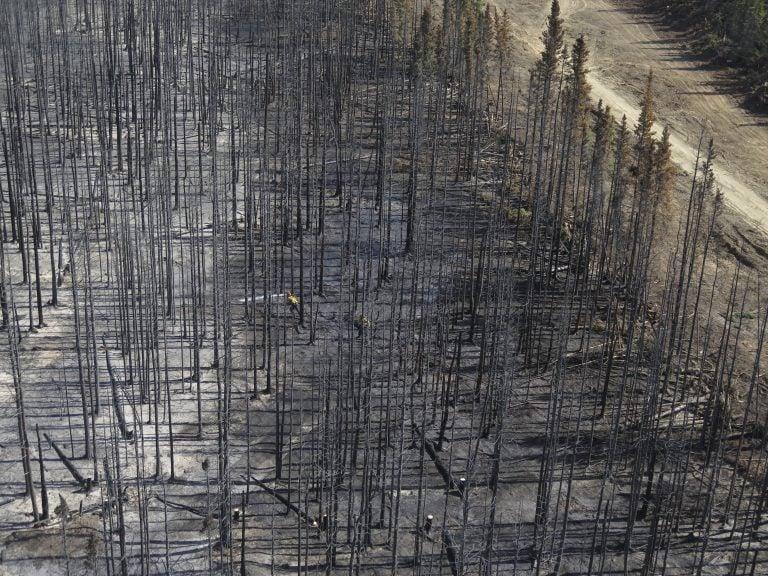This summer, Canada’s land of ice was on fire
Hundreds of wildfires, some visible from space, swept across the Arctic Circle this summer—and as they burned, these northern firefighters faced down the changing climate

Firefighters at work in a stretch of scorched trees in Bear Creek, Southwest Yukon (Government of Yukon)
Share
Chad Thomas started fighting wildfires at 16, sacrificing every summer since battling the blazes that claim ever-growing tracts of the Yukon’s boreal forest and peatlands. As a young firefighter from the village of Teslin, he’s required to jump out of helicopters to fend off flames in the most remote regions of the country, and he took pride until recently in never allowing a structure to become ashes. But he’s a key observer of a changing environment. Wildfire season in the territory is beginning earlier; the fires are hotter and move faster. Seasonal combustion is natural to the North, but scientists say there’s a reason for the newfound ferocity of northern fires: a warming Arctic.
For firefighters like Thomas, this means confronting unwinnable scenarios. He was on the ground in Telegraph Creek, B.C., last year, when wildfires ravaged 21 homes and left the community under an evacuation order for 102 days. Telegraph Creek includes the Tahltan First Nation, of which Thomas is a member, so the fire hit close to home. “I had friends’ homes burn,” he says. “There was nothing I could do.”
Now 31, he is the CEO of Yukon First Nations Wildfire, a firefighting service that draws from eight Indigenous governments across the territory. This season was the organization’s first on the ground, with 80 trained firefighters. At the time of this writing, there had been 111 wildfires in the Yukon in 2019, and 44 were still active. The total hectares burned—252,902—is nearly 50 per cent more than the territory’s 10-year average. “There’s a very healthy sense of fear,” says Thomas, “not just in First Nations but among all members of the North.”
READ MORE: Climate change is making wildfires in Canada bigger, hotter and more dangerous
Hundreds of wildfires, some visible from space, swept across the Arctic Circle this summer—a rare event scientists link to the breathtaking pace with which the region is heating up. The circumpolar zone is warming three times faster than the rest of the world, and 2019 brought its hottest summer on record, fuelling fires whose carbon output will speed the disastrous climate cycle.
Arctic fires throughout June in Alaska, Canada, Greenland and Russia emitted 79 megatons of carbon dioxide into the atmosphere, according to the European Union’s Copernicus Atmosphere Monitoring Service (CAMS)—more than the entire annual emissions of the nation of Sweden. “It’s quite unusual to see so many focused in particular parts of the Arctic Circle, and that they last for such a long period of time,” says Mark Parrington, a climate scientist at CAMS.
Mike Flannigan, a professor in the University of Alberta’s renewable resources department and director of the Canada Wildfires, says three ingredients go into making a wildfire: fuel, ignition (in this case, usually lightning) and, most importantly, weather that is warm, dry and windy. Weather, he says, influences the other two. More worrying still is what’s being burned. Peat is a thick, organic material found within and above the Arctic treeline that has been storing and accumulating carbon over millennia. As the North becomes drier, peatland fires spread further and burn deeper, releasing harmful greenhouse gases like methane. Black soot falls on Arctic sea ice, accelerating melting. Says Flannigan: “The warmer it gets the more fire we see; more fire means more greenhouse gases, which makes it even warmer.”
Yukon officials have no choice but to adapt. At a meeting of the Arctic Council in August, a representative of Gwich’in peoples in the Yukon, the Northwest Territories and Alaska warned that “terrible air quality” is threatening people’s health and making their lives miserable. Wildfires in Alaska have devastated an area larger than the one that fires left behind in California last year.
This year, once again, a handful of Yukon fires have made the previously uncommon transit across the Arctic Circle, but the threat to property and people has been greater in the subarctic part of the territory. Residents of Keno City, a mining town 464 km north of Whitehorse, were at risk of being evacuated in July. “Every community here feels close to wildfire,” says MLA John Streicker, the Yukon’s minister of community services. “In the past, if we talked about cutting down trees, we would be bound to hit some resistance.” Now, when Streicker attends town halls, he’s met by locals urging him to move the dial on prevention and addressing climate change, even if it means levelling some forest.
Wildfires are typically left to burn if they are not a threat to local society, but the territorial government is preparing for when fires inevitably put communities at risk, devising evacuation plans, thinning out the fuel around towns and villages, and conducting prescribed burns.
Few take comfort knowing this year’s fire total is not enormously high—not, at least, by recent standards. Last year saw 67 fires burn 86,000 hectares. But, the year before, 115 scorched 471,000 hectares—the most in a decade. Damien Burns, the territory’s director of wildfire management, says the fires that do start are burning “hotter, deeper, and they’re a little harder to suppress.” Even when snow covers the ground, fires can smolder in the peat throughout winter.
Thomas, for one, has felt plenty busy, and says more firefighters are needed in the Arctic. His organization has drawn interest from communities in B.C., Alberta and Alaska, where big, long-lasting fires have become part of life. Thomas believes Indigenous people, as stewards of the land, will play an essential role in the fight against them. “Nobody really knows where these fires are going to start next,” he says. “All we can do is train our folks to the best of our ability, and be prepared when that call does come.”
[linknav category=”536974″]